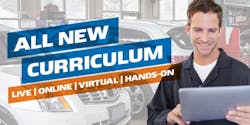As a not-for-profit organization created by the collective automotive collision repair industry to provide training programs, I-CAR® is proud to roll out a renewed and revamped industry knowledge and skills protocol—the industry-wide adoption of training to contribute to consistent, uniform, efficient practices for all automotive trainers and trainees. The protocol considers the future of collision repair, contributing to the industry’s objective of complete, safe and quality repairs for the ultimate benefit of the consumer.
“The protocol is something the industry has been asking about for years,” says David Parzen, Director of Protocols, Licensing and Quality Management at I-CAR.
“The protocol defines the role-relevant knowledge and skills that prepare a technician, and ultimately a shop, for collision repairs,” he adds.
David also noted that as many as 58 percent of shops aren’t training at all.
“That’s a terrifying figure, and one we hope to diminish,” he says.
Any sweeping change to any industry can seem like a challenge. Like a pebble in a pond, though, one plunk can create more waves than most imagine.
In other words, I-CAR is helping shops and technicians with a training framework for being ready.
How Does the Protocol Serve the Industry?
Parzen has made a career out of analyzing, implementing and seeing protocol change the automotive industry before joining I-CAR earlier this year.
“My history of writing standards and protocols equipped me well. I understood quickly the need we are filling in the industry and I was really excited about it.”
I-CAR has further defined the knowledge and skills necessary for the key roles across the repair process and is streamlining the training options available to every technician, trainer and/or owner, and for each trainee to be able to specialize more crucially for their given skill sets.
“The training options to achieve I-CAR Gold Class® or Platinum™ all relates back to the protocol which coupled with the Industry Training Alliance program creates a sort of open source option for getting the training necessary for knowledge and skills outlined in the protocol.”
The industry knowledge and skills protocol is equipped to offer long-term solutions to foster better skill sets, teamsmanship and the ability to grow within the industry.
Parzen sees the snowball effect of the new protocol as nothing but promising for collision repair.
The I-CAR Positive Training Feedback Loop
Ever heard of a Mobius strip? It’s a surface without end—think of a rubber band with a single twist in the center. No matter which side you start on, you can traverse both sides without ever crossing an edge.
That’s how Parzen sees the protocol working with the curriculum.
“It’s a positive feedback loop,” he says.
“The curriculum is designed to support the protocol, and that’s how it should be. The protocol should dictate how curriculum is developed or modified. As the knowledge and skill areas of the protocol evolve, I-CAR can focus on developing new curriculum to keep pace with those changes.”
Very cool. The Automotive Collision Repair Industry Knowledge and Skills Protocol will help guide students in their specialized roles. Once shops have an estimator who needs to be trained, for example, all the new Gold Class and Platinum enhancements are derived directly from the protocol. In other words, the foundation I-CAR has established with its updated curriculum is informed by the protocol, so students all stand on the same foundation no matter their skill level or proficiency within the industry and/or I-CAR training. Shops have the ability to easily enroll to gain new skills, knowledge and variants within their specialties.
Preparing for a Future Foundation of High-Quality Repairs
Parzen notes that more than anything, the new protocol helps I-CAR stay focused to develop curriculum that fulfills knowledge and skill areas identified by the industry and eliminate training redundancies.
Parzen pauses, reflecting on what 2019 has meant for I-CAR and the tens of thousands of owners, technicians, service advisors and support staff it serves.
“When the protocol was finally published earlier this year,” he says, “it was a monumental achievement for I-CAR and the entire industry. The protocol is the heart and soul of our mission and vision. Part of I-CAR’s mission is to deliver increasingly relevant education for the collision repair Inter-Industry. The protocol defines the knowledge and skill areas shop technicians need to perform complete, safe, and quality repairs. Students should take training based on the knowledge and skills defined within the protocol. They should always be asking and evaluating which knowledge and skills are prevalent in any training class.”
As 2019 calendars flip to 2020—the third decade in the new, technologically driven collision repair industry—I-CAR is prepared to keep up with the times, the technology and to equip its shops with the tools and skill sets needed for safe, high-quality repairs.
Click here to learn more about I-CAR and its exciting new protocol.
About the Author
Sponsored Content
The views and opinions expressed in this piece do not necessarily reflect those of 10 Missions Media and its associated brands.
